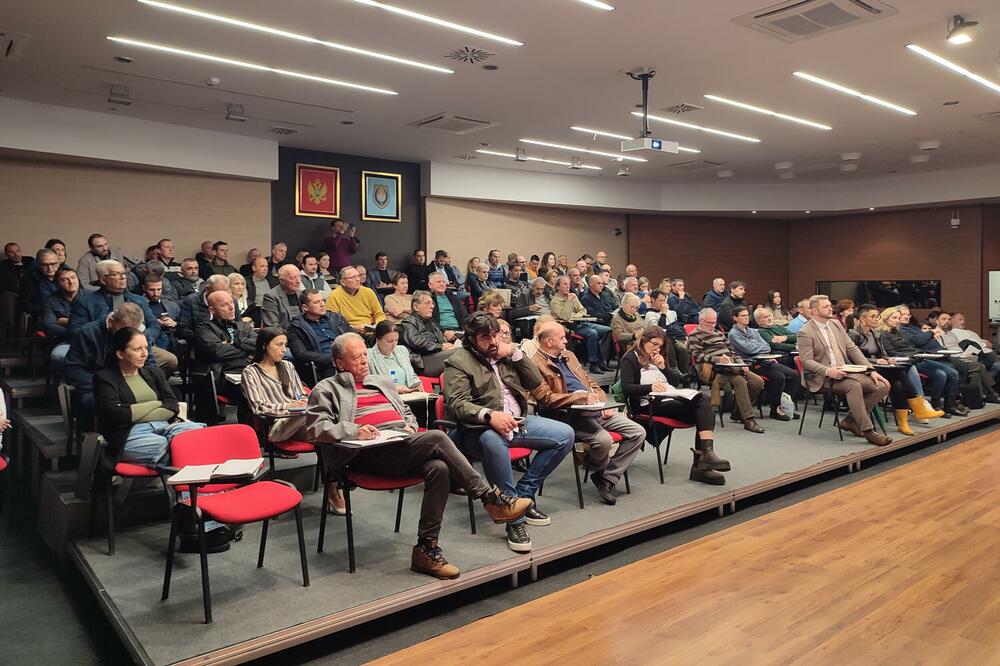The huge interest of the citizens, the multimedia hall of the Municipality full of holes in which more space was sought and the discussion that lasted more than four hours marked the round table on the draft of the Spatial Plan of Montenegro until 2040, which was organized yesterday by the Ministry of Spatial Planning, Urbanism and State Property held in Tivat.
Master planner Svetlana Jovanovic pointed out that the planning team is very attached to the input it receives from local self-governments and that it is her personal "intention that the municipalities be maximally involved in this process".
"The state and local level must cooperate and communicate better and more intensively, and in the field of spatial planning, it is necessary to give greater authority to local self-governments, which will be done with the new legal solutions that are being prepared," said Jovanović.
Citizens showed the most interest in the corridor of the planned future high-speed coastal road, which, as pointed out, will go through the hinterland of coastal cities at higher elevations than the current Adriatic highway, and an integral part of which will be bypasses around coastal cities. Jovanović pointed out that the draft PP includes a solution for that road through Boka via the Luštica peninsula, which was once sought by the Administration for the Protection of Cultural Property as an alternative to solutions that could threaten the status of the Bay of Kotor on the UNESCO list of world natural and cultural heritage.
"Neither our experts, nor the foreign experts who were engaged in this matter, do not recommend a corridor through Luštica for this part of the high-speed coastal road, but instead propose a corridor that corresponds to the greatest extent to the route parallel to the existing highway, at higher altitudes above the cities and bypasses which will be an integral part of this road. Therefore, it is proposed to cross that road across the bay in the region Cape Sveta Nedjela-Cape Opatovo, but not by building a bridge, but leaving the possibility that an adequate crossing solution that will not endanger the UNESCO area will be found by experts at the level of technical projects. In any case, the high-speed road corridor through Luštica was deleted because it is an inefficient, very expensive, environmentally and spatially problematic solution," Jovanović explained.
When it comes to citizens' interest in the gas pipeline corridor that should reach Croatia from Azerbaijan through Turkey, Greece, Albania and Montenegro and further towards Western Europe, which in previous plans was defined through the coastal region of Montenegro, Jovanović is concerned with that, she said that there is no corridor or gas pipeline route drawn in the PP draft, but that in the textual part of the plan "only the strategic possibility is left that Montenegro may at some point in the future start this story and the construction of the gas pipeline".
"However, as things stand now, Montenegro does not have any great benefits from that gas pipeline, and it would have great investments," underlined Jovanović, to whom the citizens suggested that a potential gas pipeline corridor should still be drawn in the PP draft, but not across the coast. but the least attractive land in the hinterland, such as the so-called Kameni moro in Cuce, so that "some investor would not take advantage of these potential ambiguities tomorrow and insist that the gas pipeline be built for him in the cheapest way between Grblje, Krtol and Luštica and through part of the Montenegrin territorial sea".
The citizens also pointed to the problems brought about by the centralization of planning and decision-making on the area, as well as pandering to the interests of foreign investors through numerous state location studies that were made for the most attractive parts of the coast, which are often inconsistent with the higher-order plans that have been valid up to now. As one of such negative examples, DSL "Arsenal" was singled out, i.e. its changes from 2018, which the Government then openly admitted were done in accordance with the wishes and needs of the investor "Portro Montenegro", which resulted in the design of multi-story buildings inappropriate for the environment, significant by increasing the built-up coefficients of the area and even filling the sea for the construction of residential buildings.
"'Porto Montenegro' is already selling a square meter apartment in the new building in the new settlement 'Synchro', which will be surrounded by the sea on three sides and partially built in the sea, at a price of 21.000 to 25.000 euros per square meter. Where is the public interest and where is the public interest in mapping marinas, piers and moorings literally on every part of our coast. Our children no longer have a place to bathe in the sea in their own town," said the civil engineer Ljubo Samardzic who pointed out that everything was fine with the coast of Tivat and there were no urban and ecological problems while the coast was being planned and the Municipality was wondering about it.
Bonus video:





